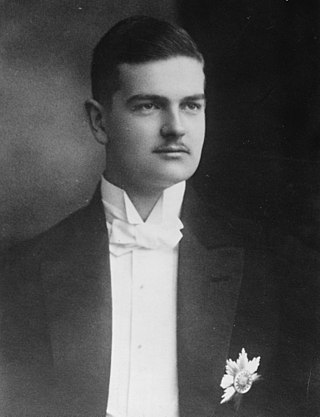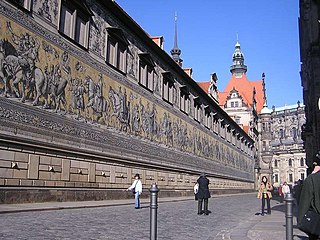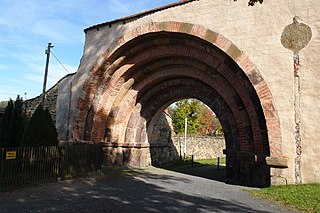Related Research Articles
Gertrud of Brunswick was Countess of Katlenburg by marriage to Dietrich II, Count of Katlenburg, Margravine of Frisia by marriage to Henry, Margrave of Frisia, and Margravine of Meissen by marriage to margrave Henry I.

Albert Leopold Friedrich Christian Sylvester Anno Macarius, Prince of Saxony, Duke of Saxony, Margrave of Meissen was the second son of Frederick Augustus III, the last reigning king of Saxony before the abolition of the monarchy in 1918. Upon his father's death in 1932, he became the head of the Royal House of Saxony. He was Captain à la suite in the Royal Bulgarian Infantry, and Grand Master of the Order of the Rue Crown, and also a Knight in the Order of the Black Eagle and Knight Grand Cross in the Sovereign Military Order of Malta. As head of the Albertine branch of the House of Wettin after 1932, he styled himself as Friedrich Christian, Margrave of Meissen.
Prince Albert Joseph Maria Franz-Xaver of Saxony, Duke of Saxony, Margrave of Meissen was the head of the Royal House of Saxony and a German historian. The fourth child and youngest son of Friedrich Christian, Margrave of Meissen and his wife Princess Elisabeth Helene of Thurn and Taxis, he was the younger brother of Maria Emanuel, Margrave of Meissen, who was his predecessor as head of the Royal House of Saxony.
Conrad I, called the Great, a member of the House of Wettin, was Margrave of Meissen from 1123 and Margrave of Lusatia from 1136 until his retirement in 1156. Initially a Saxon count, he became the ruler over large Imperial estates in the Eastern March and progenitor of the Saxon electors and kings.

Wiprechtof Groitzsch was the Margrave of Meissen and the Saxon Ostmark from 1123 until his death. He was born to a noble family of the Altmark, the son of Wiprecht of Balsamgau and Sigena of Leinungen. After his father's death in 1060, he was raised at the court of Lothair Udo II, Margrave of the Nordmark, in Stade.
Otto II, the Rich, a member of the House of Wettin, was Margrave of Meissen from 1156 until his death.
Rüdiger von Sachsen was a claimant to the Headship of the Royal House of Saxony.

The Fürstenzug in Dresden, Germany, is a large mural of a mounted procession of the rulers of Saxony. It was originally painted between 1871 and 1876 to celebrate the 800th anniversary of the Wettin Dynasty, Saxony's ruling family. In order to make the work weatherproof, it was replaced with approximately 23,000 Meissen porcelain tiles between 1904 and 1907. With a length of 102 metres (335 ft), it is known as the largest porcelain artwork in the world. The mural displays the ancestral portraits of the 35 margraves, electors, dukes and kings of the House of Wettin between 1127 and 1904.

The Dohna Feud was a 14th-century dispute between the burgraves of Dohna, who resided in the Eastern Ore Mountains of Central Europe, on the one hand and Saxon nobleman, John of Körbitz and the Meißen Margrave William I on the other. The feud lasted from 1385 to 1402.

Hedwig of Brandenburg, also called Hedwig of Ballenstedt, a member of the House of Ascania, was Margravine of Meissen from 1156 until 1190 by her marriage with Margrave Otto II.

Albert I, called the Proud, a member of the House of Wettin, was the Margrave of Meissen from 1190 until his death.

Altzella Abbey, also Altzelle Abbey, is a former Cistercian monastery near Nossen in Saxony, Germany. The former abbey contains the tombs of the Wettin margraves of Meissen from 1190 to 1381.
Margrave Conrad II of Lusatia, also known as Margrave Konrad II of Landsberg, was a member of the House of Wettin. He was Count of Eilenburg and Margrave of Lusatia from 1190 until his death. From 1207, he was also Count of Groitz and Count of Sommerschenburg. He was a son of Margrave Dedi III and his wife, Matilda of Heinsberg, the heiress of Sommerschenburg.
Saint Burchard of Meissen was the first Bishop of Meissen, from 968.
Volkold of Meissen was the second Bishop of Meissen.
Godebold of Meissen, was Bishop of Meissen from 1119 to 1140.
Gerung was bishop of Meissen from 1152 to 1170, and previously abbot of Posa or Bosau Abbey.
Dietrich von Kittlitz otherwise Dietrich II of Meissen or Dietrich II von Kittlitz was Bishop of Meissen from 1191 to 1208.
Albrecht von Mutzschen otherwise Albrecht II of Meissen or Albrecht II von Mutzschen was Bishop of Meissen from 1258 to 1266.

The history of Saxon coinage or Meissen-Saxon coinage comprises three major periods: the high medieval regional pfennig period, the late medieval pfennig period and the thaler period, which ended with the introduction of the mark in 1871/72. Rich silver deposits, which were discovered near Freiberg after the middle of the 12th century, helped Saxony to a leading position in German coinage.
References
- ↑ "Altzella Abbey". www.visit-dresden-elbland.de. Retrieved 2024-07-23.